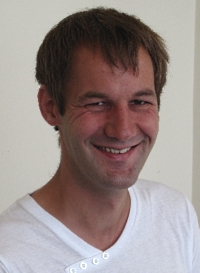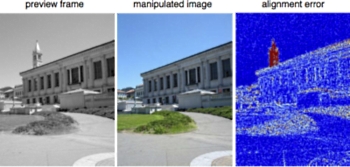Impeding Forgers at Photo Inception
 Guest post by Matthias Kirchner
Guest post by Matthias Kirchner
Digital images have become ubiquitous companions of our everyday life. At the same time, the very nature of digital data puts into question many of the positive aspects that we usually associate with digital images. Digital data can be manipulated easily. Powerful editing software, which allows even inexperienced users to conveniently process digital images in innumerable ways, raises questions regarding the authenticity of digital images. Manipulated images rapidly distribute over the Internet, may be unknowingly or purposely published in the news, or may even be used as pieces of evidence in the court.
Within the last decade, the study of digital image forensics has led to a large and varied set of techniques for authenticating images. These techniques generally work by observing that specific forms of tampering disrupt some statistical, geometric, or physical property in an image. When such a disruption can be detected, an image can be revealed to be a fake. In a recent study, I worked with Dartmouth College researchers Peter Winkler and Hany Farid to consider the problem of image forensics from a different perspective. We describe how to make photo tampering more difficult, time consuming, and hence more error-prone, for a forger.
Conceptually our approach follows the idea that the more information that a camera records, the more difficult and time consuming it will be for a forger to create a compelling fake. At the simplest level, a high-resolution color image is harder to convincingly fake than a low-resolution grayscale image. Similarly, manipulating a pair of images from a stereo camera requires that two images be changed and that the changes be consistent with the 3-D scene structure. While such data-rich recordings of a scene do not make tampering impossible, they do make it more difficult, more time consuming, and more likely to leave evidence of tampering.
Instead of relying on specialized stereo or light field cameras, we decided to leverage the existing hardware available in virtually all commercial digital cameras and mobile devices. We wrote an app for Android phones that records a portion of the camera preview and the camera's own motion data, and stores it with the actual image. This additional data can be used in a later stage to verify that the few moments in time recorded prior to final image capture are consistent with the full resolution image. Recording even only a few seconds of the digital preview means that a forger must now propagate any image manipulation through several dozen preview frames. Recording the camera's own motion means that the 3-D structure of a forged preview must be made consistent with the recorded camera motion.

The recorded preview frame and the manipulated full-resolution image differ substantially. Large alignment errors (printed in red) indicate the manipulated region.
While a visual inspection of this auxiliary data may often suffice to validate its consistency, we also describe an automated, software-based verification approach, which is needed to validate a large number of images. This method performs a pairwise geometric and photometric alignment of sequential preview frames, which can then be compared to the full resolution image. Based on a spatial segmentation of the pixel-wise alignment errors, image regions that have a higher than expected inter-frame difference are flagged as suspicious.
Experimental results demonstrate a high reliability of the proposed approach, even when preview frames are stored at a low resolution (320x240 pixels) and JPEG compression quality (85). For image manipulations that affect only 1 percent of the full resolution image, 85 percent of the manipulated images were detected with a 0 percent false positive rate.
We expect that as digital cameras and mobile devices add new sensors (e.g., ambient light and proximity sensors), even more pieces of data can be recorded and then used to impede a forger. Such an approach will require either a specialized smart phone camera application (as described here), or the cooperation of camera manufacturers.
Related Paper:
"Impeding Forgers at Photo Inception." Matthias Kirchner, Peter Winkler, and Hany Farid. Proceedings of SPIE 8665, Media Watermarking, Security and Forensics 2013, San Francisco, California, February 2013.
Bio:
Matthias Kirchner has been a post-doctoral research fellow at ICSI since 2011. Before joining ICSI, he received a PhD degree in computer science from the Technical University of Dresden, Germany, and he was member of the IT Security Research group at the University of Münster, Germany. His research interests focus on all aspects of multimedia forensics and counter-forensics. He was co-organizer and program chair of the 2012 14th International Information Hiding Conference in Berkeley. He has served in technical program committees of various international workshops and conferences, including the IEEE International Conference on Multimedia and EXPO, the IEEE International Conference on Image Processing, and the ACM Workshop on Information Hiding and Multimedia Security.
